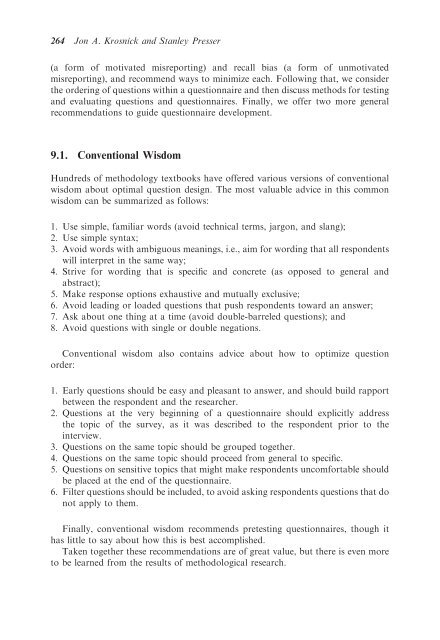264 Jon A. Krosnick <strong>and</strong> Stanley Presser(a form of motivated misreporting) <strong>and</strong> recall bias (a form of unmotivatedmisreporting), <strong>and</strong> recommend ways to minimize each. Following that, we considerthe ordering of questions within a questionnaire <strong>and</strong> then discuss methods for testing<strong>and</strong> evaluating questions <strong>and</strong> questionnaires. Finally, we offer two more generalrecommendations to guide questionnaire development.9.1. Conventional WisdomHundreds of methodology textbooks have offered various versions of conventionalwisdom about optimal question design. The most valuable advice in this commonwisdom can be summarized as follows:1. Use simple, familiar words (avoid technical terms, jargon, <strong>and</strong> slang);2. Use simple syntax;3. Avoid words with ambiguous meanings, i.e., aim for wording that all respondentswill interpret in the same way;4. Strive for wording that is specific <strong>and</strong> concrete (as opposed to general <strong>and</strong>abstract);5. Make response options exhaustive <strong>and</strong> mutually exclusive;6. Avoid leading or loaded questions that push respondents toward an answer;7. Ask about one thing at a time (avoid double-barreled questions); <strong>and</strong>8. Avoid questions with single or double negations.Conventional wisdom also contains advice about how to optimize questionorder:1. Early questions should be easy <strong>and</strong> pleasant to answer, <strong>and</strong> should build rapportbetween the respondent <strong>and</strong> the researcher.2. <strong>Question</strong>s at the very beginning of a questionnaire should explicitly addressthe topic of the survey, as it was described to the respondent prior to theinterview.3. <strong>Question</strong>s on the same topic should be grouped together.4. <strong>Question</strong>s on the same topic should proceed from general to specific.5. <strong>Question</strong>s on sensitive topics that might make respondents uncomfortable shouldbe placed at the end of the questionnaire.6. Filter questions should be included, to avoid asking respondents questions that donot apply to them.Finally, conventional wisdom recommends pretesting questionnaires, though ithas little to say about how this is best accomplished.Taken together these recommendations are of great value, but there is even moreto be learned from the results of methodological research.
<strong>Question</strong> <strong>and</strong> <strong>Question</strong>naire <strong>Design</strong> 2659.1.1. Optimizing versus SatisficingThere is widespread agreement about the cognitive processes involved in answeringquestions optimally (e.g., Cannell, Miller, & Oksenberg, 1981; Schwarz & Strack, 1985;Tourangeau & Rasinski, 1988). Specifically, respondents are presumed to execute eachof four steps. First, they must interpret the question <strong>and</strong> deduce its intent. Next, theymust search their memories for relevant information, <strong>and</strong> then integrate whateverinformation comes to mind into a single judgment. Finally, they must translate thejudgment into a response, by selecting one of the alternatives offered by the question.Each of these steps can be quite complex, involving considerable cognitivework (see Tourangeau & Bradburn, this volume). A wide variety of motives mayencourage respondents to do this work, including desires for self-expression,interpersonal response, intellectual challenge, self-underst<strong>and</strong>ing, altruism, oremotional catharsis (see Warwick & Lininger, 1975, pp. 185–187). Effort can alsobe motivated by the desire to assist the survey sponsor, e.g., to help employersimprove working conditions, businesses design better products, or governmentsmake better-informed policy. To the extent that such motives inspire a respondentto perform the necessary cognitive tasks in a thorough <strong>and</strong> unbiased manner, therespondent may be said to be optimizing.As much as we hope all respondents will optimize throughout a questionnaire,this is often an unrealistic expectation. Some people may agree to complete aquestionnaire as result of a relatively automatic compliance process (see, e.g.,Cialdini, 1993) or because they are required to do so. Thus, they may agree merely toprovide answers, with no intrinsic motivation to make the answers of high quality.Other respondents may satisfy whatever desires motivated them to participate afteranswering a first set of questions, <strong>and</strong> become fatigued, disinterested, or distracted asa questionnaire progresses further.Rather than expend the effort necessary to provide optimal answers, respondentsmay take subtle or dramatic shortcuts. In the former case, respondents may simplybe less thorough in comprehension, retrieval, judgment, <strong>and</strong> response selection.They may be less thoughtful about a question’s meaning; search their memories lesscomprehensively; integrate retrieved information less carefully; or select a responsechoice less precisely. All four steps are executed, but less diligently than whenoptimizing occurs. Instead of attempting the most accurate answers, respondentssettle for merely satisfactory answers. The first answer a respondent considers thatseems acceptable is the one offered. This response behavior might be termed weaksatisficing (Krosnick, 1991, borrowing the term from Simon, 1957).A more dramatic shortcut is to skip the retrieval <strong>and</strong> judgment steps altogether.That is, respondents may interpret each question superficially <strong>and</strong> select what theybelieve will appear to be a reasonable answer. The answer is selected withoutreference to any internal psychological cues specifically relevant to the attitude,belief, or event of interest. Instead, the respondent may look to the wording of thequestion for a cue, pointing to a response that can be easily selected <strong>and</strong> easilydefended if necessary. If no such cue is present, the respondent may select an answercompletely arbitrarily. This process might be termed strong satisficing.
















